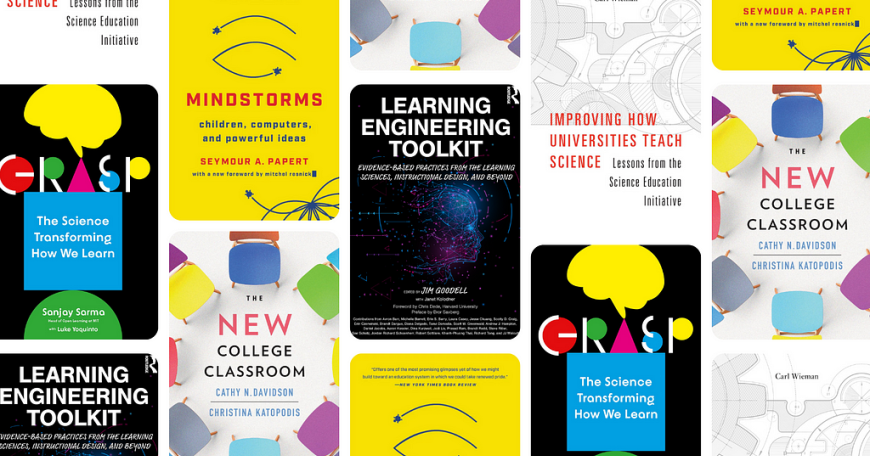
Five must-read books on teaching, learning, and digital technologies
This National Reading Month, MIT Open Learning experts share their favorite books based on cutting-edge learning science research.
By Katherine Ouellette
In today’s rapidly evolving educational landscape, the intersection of teaching, learning, and digital technologies plays a crucial role in shaping the future of education. We asked MIT Open Learning experts to recommend their favorite books on pedagogical best practices that are based on cutting-edge learning science research.
Whether you’re looking to enhance your teaching methods, are interested in understanding how learning works, or curious about technology’s impact on education, here are five highly recommended books from Eric Grimson, vice president for Open Learning, Cynthia Breazeal, dean for digital learning, and Christopher Capozzola, senior associate dean for Open Learning.
Grasp: The Science Transforming How We Learn
Lectures, homework, and tests are still the primary teaching methods in the classroom, but the science of learning proves this approach needs to change. “Grasp” examines how people learn through the lenses of effective pedagogy, fundamental neuroscience, and cognitive psychology. Examine the past, present, and future of education from the expert perspectives of educators, researchers, and innovators at MIT and beyond. Sanjay Sarma is the former vice president of MIT Open Learning and a professor of mechanical engineering at MIT, and Luke Yoquinto is a research associate at the MIT AgeLab.
Improving How Universities Teach Science: Lessons from the Science Education Initiative
Many university professors teach the sciences with ineffective methods but don’t have the time to test new strategies. “Improving How Universities Teach Science” offers concrete, attainable, and proven solutions that help educators disseminate scientific concepts to their students. Higher education institutions and departments will learn how to measure their own success when implementing the book’s comprehensive strategies. This book draws from Carl Wieman’s experiences as a professor of physics and education at Stanford University, the founding chair of the National Academy of Sciences’ Board on Science Education, and the creator of the Science Education Initiative — a program that supported the widespread adoption of research-based approaches for teaching science.
Learning Engineering Toolkit: Evidence-Based Practices from the Learning Sciences, Instructional Design, and Beyond
Learning engineering is a fast-growing discipline that combines the learning sciences, instructional design, and engineering design to create teaching methods that best support learners’ needs. Using actionable steps from the “Learning Engineering Toolkit,” educators can create engaging data-driven learning experiences for a variety of contexts across different populations. In three chapters, Aaron Kessler, assistant director of learning sciences and teaching at MIT Open Learning, discusses the process of learning engineering and how it applies the science of learning.
“What Is Learning Engineering?”, an excerpt from the book, is available to download as a free PDF under a Creative Commons Attribution-Noncommercial-No Derivatives 4.0 license.
Mindstorms: Children, Computers, And Powerful Ideas
The late MIT Professor Emeritus Seymour Papert foresaw how computers could revolutionize education as early as the 1960s. In his book “Mindstorms,” first published in 1980, Papert argued that computer programming not only can help a child acquire “a sense of mastery over a piece of the most modern and powerful technology,” but establish “an intimate contact with some of the deepest ideas from science, from mathematics, and from the art of intellectual model building.” The computing technologies may have changed but Papert’s educational theories still hold true. Teaching basic computing concepts can help students unlock new ways of learning, adapt to ever-evolving technologies, and even improve socialization with classmates and teachers.
The New College Classroom
Are you an educator who wants your students to become independent, creative, and active learners? Teachers from any discipline or higher education institution can adopt ready-made strategies from “The New College Classroom.” Authors and education experts Cathy Davidson and Christina Katopodis incorporate cutting-edge research about pedagogies and the learning sciences into this guide. These empirically driven, active learning-based tools and activities have been tested in classrooms at community colleges and research universities. The authors share case studies of how these techniques “achieved impressive results” preparing students for the workforce.
Five must-read books on teaching, learning, and digital technologies was originally published in MIT Open Learning on Medium, where people are continuing the conversation by highlighting and responding to this story.

